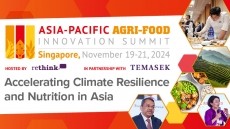Asia dominates vegetarian markets but understanding local factors crucial for sales success

These countries are India (390 million), Indonesia (66.9 million), China (51.9 million) and Pakistan (33.2 million), according to market research firm Euromonitor International.
In comparison, Nigeria has 58.1 million vegetarians.
In terms of the percentage of the population, the top Asian markets are India (29.8%), Indonesia (25.4%), Pakistan (16.8%) and China (3.8%).
The high rate of vegetarianism in Asia is no surprise considering the region’s history.
At the recent Healthy Ageing APAC Summit organised by FoodNavigator-Asia and NutraIngredients-Asia, Eugene Wang, founder of plant-based seafood firm Sophie’s Kitchen, said, historically, Buddhist vegetarian dietary laws greatly impacted cuisine in China and East Asia especially.
He said tofu-making was first recorded in the Han dynasty, about 2,000 years ago.
Today, whether due to religion, altruism, environmental concern or health — among the commonly-cited factors — the size of the vegan and vegetarian populations across the Asia-Pacific region, and corresponding products from food manufacturers, are undoubtedly increasing.
Euromonitor shared with us insights on Asia’s largest vegetarian markets and some factors impacting the food industry in these countries.
India
An Hodgson, income & expenditure manager at Euromonitor, told us, “Vegetarianism is part of India’s culture, rooted in the country’s class and religious systems. However, the number of Indian vegetarians is declining, driven mainly by rising living standards and urbanisation, as more Indians can afford meat and have access to a wider variety of food and other lifestyles.”
Another ‘mitigating’ factor is the growing trend of “closet non-vegetarians” — those who are vegetarians at home (perhaps for religious adherence) but consume non-vegetarian food outside the home.
Hodgson said this is the direct result of rising incomes but also the increasing popularity of eating out at restaurants and fast-food outlets among the younger generation.
Nonetheless, the Indian vegetarian market remains huge.
“Even among a majority of Hindu non-vegetarians, consumption of meat is restricted to a few fixed days of the week due to religious proscription,” Hodgson explained.
Indonesia
Meanwhile, according to Euromonitor, the number of Indonesian vegetarians is growing largely because of the rising Buddhist and Hindu populations.
On the other hand, Indonesians tend to consume more meat as their incomes rise, making meat the second-fastest-growing consumer spending food category from 2012 to 2017.
Despite this, Hodgson said a portion of Indonesian consumers are becoming more health conscious, and are being influenced by government health campaigns and easier access to health-related information online.
Particularly, middle-to-upper urban Indonesian consumers are migrating towards healthier diets and becoming vegan, vegetarian or flexitarian (plant-based diet with occasional meat).
She highlighted that the UK brand Quorn — known for vegetarian meat products such as chicken fillets, sausages, chicken nuggets and burgers — launched some of its products in Indonesia late last year in response to this demand.
China
While China has a large vegetarian population, it is also declining. Like its neighbours, rising living standards have led to a significant increase in meat consumption — connected to the traditional perception of meat as good nutrition and meat consumption as an indication of prosperity.
However, in large cities such as Shanghai and Beijing, a plant-based diet has become a popular alternative lifestyle choice, particularly among the youth, due to growing awareness about the environment, animal welfare and health issues.
“The revival of Buddhism recently also helps to fuel consumers’ passion for vegetarianism, boosting demand for plant-based protein, fresh and organic vegetables, as well as vegan or vegetarian restaurants,” added Hodgson.
She cited Shenzhen Whole Perfect Food Co. Ltd., a leading producer of packaged vegetarian food in China and other parts of the world, as having published numerous recipe books, CDs and a Health and Vegetarian magazine in several markets to promote vegetarian culture and gain brand recognition.
Pakistan
Hodgson said Pakistan’s vegetarian population is expanding in both absolute and relative terms.
Hoang-Lan Ha, contributing analyst at Euromonitor, elaborated to FoodNavigator-Asia that this referred to the total number of vegetarians having grown from 26.2 million in 2012 to 33.2 million in 2017, and the share of the vegetarian population having increased from 14.7% in 2012 to 16.8% in 2017.
This has primarily been driven by strong population growth, particularly in the rural areas.
With Pakistan’s low income levels and rapidly-inflating meat prices, meat remains unaffordable for a significant proportion of the population, particularly in rural Pakistan where poverty is rife.
Nevertheless, vegetarianism is also being chosen by a portion of affluent Pakistani consumers due to growing health, food safety and ethical and environmental concerns.
“Meat-free products such as ‘veggie burgers’ are entering Pakistan at a very a slow pace but are being introduced in some restaurants,” she said.
Australia
Aside from the data from Euromonitor, based on the Mintel Global New Products Database (GNPD), between 2014 and 2016 there was a 92% increase in the number of food products launched in Australia with a vegan claim, and an 8% increase in products launched with a vegetarian claim.
On top of that, 12% of food products launched in Australia in 2016 were vegetarian.
We reported that Australia is the third fastest-growing vegan market in the world.
Wang also said that interest in alternative protein is rapidly growing across Asia-Pacific but food firms need to rethink their approach to Asian preferences.


















